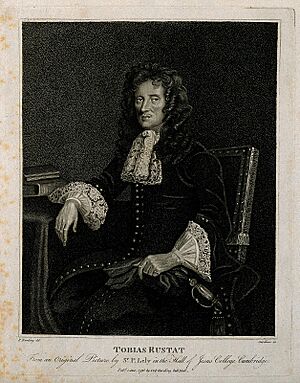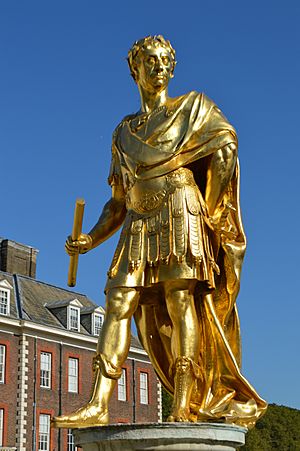Tobias Rustat facts for kids
Tobias Rustat (born 1608 – died 1694) was a special helper to King Charles II and a generous supporter of the University of Cambridge. He is remembered for starting the first fund to buy books for the Cambridge University Library. He also invested in and helped run the Royal African Company. This company was deeply involved in the slave trade, which meant buying and selling enslaved people from Africa.
Contents
Life of Tobias Rustat
Rustat was born in a place called Barrow upon Soar in Leicestershire, England. His father, Robert, was a vicar, which is a type of church leader. Tobias was baptized on September 17, 1608.
After learning to be a barber-surgeon in London, Rustat started working for important people. He worked for Basil Feilding, the Earl of Denbigh, and then for George Villiers, the Duke of Buckingham. Rustat was a strong supporter of the King (a Royalist). He secretly carried messages between England and the King's court when the King was in exile. During a war in 1648, Rustat even saved the Duke of Buckingham's life. He later helped King Charles II escape after a big battle in 1651.
In 1650, Rustat became the Yeoman of the Robes for King Charles II. This meant he was in charge of the King's clothes and personal items. He stayed in this job until the King died in 1685. Rustat became wealthy because of his work for the King and his strong loyalty. He invested in several trading companies, including the Royal African Company. The King and his brother, the Duke of York, were also investors in this company.
Rustat was a director (called an "Assistant") of the Royal African Company for three years. Historians say this company transported more enslaved African people to the Americas than any other group during the time of the transatlantic slave trade. People who invested in the company, like Rustat, knew what it was doing and wanted to make money from it.
In 1675, the University of Cambridge gave Rustat a special Master of Arts degree. Rustat is buried at Jesus College, Cambridge. There is a monument there made by the famous artist Grinling Gibbons. The monument says Rustat believed that giving away money during life could bring a person closer to God after death.
Rustat's Gifts and What He Left Behind
Later in his life, Rustat gave a lot of money to different colleges at the University of Cambridge. He was especially generous to Jesus College, where his father had studied. In 1667, he created the first fund to buy books for the Cambridge University Library. He gave £1,000, which was a lot of money back then. The books bought with this money were supposed to have Rustat's family symbol stamped on them in gold and be kept together in the library.
Rustat also started a scholarship at Jesus College. This scholarship helped orphan sons of Anglican clergymen go to college. Famous people like the poet Samuel Taylor Coleridge received this scholarship. There is also a charity called Tobias Rustat's Charity that still helps vicars in Leicestershire today.
Rustat also paid for three statues of kings made by the workshop of Grinling Gibbons. These included a standing statue of King Charles II at the Royal Hospital Chelsea, a statue of Charles II on a horse at Windsor Castle, and a statue of King James II, which is now in Trafalgar Square in London.
Jesus College, Cambridge, has a painting of Rustat from 1682. It used to hang in a common room but is now stored away. A road in Cambridge, Rustat Road, was named after him. Also, some conferences at Jesus College were named the Rustat Conferences in 2009, but they were renamed the Jesus College Conferences in 2020.
There is also a small stone statue of Rustat from the late 1800s at the Old Schools, which was the first home of the University Library.
The Rustat Monument
There is a white marble monument to Rustat in the chapel of Jesus College. It was made by the studio of Grinling Gibbons. In 2020, the college suggested moving this monument out of the chapel.
Many people, including Rustat's family and some former students, did not want the monument moved. They argued that moving it would change the chapel's historical look. They also said that Rustat's connection to the slave trade was a small part of his life and was common at the time. They pointed out that his investments in the Royal African Company were a small part of his total wealth. However, the Archbishop of Canterbury, Justin Welby, said in 2022 that the monument was "a memorial to slavery" and should be removed.
A special court hearing took place in February 2022 to decide if the monument could be moved. The judge ruled that moving the monument would cause too much harm to the chapel, which is a very old and important building. The judge said Jesus College had not given strong enough reasons to move it. After this decision, the Archbishop of Canterbury repeated his view that "Memorials to slave-traders do not belong in places of worship."
Jesus College spent a lot of money, about £120,000, trying to move the monument. The college has decided not to appeal the court's decision.
Famous Rustat Scholars
- Nathaniel Spinckes (1653–1727), a clergyman
- David Hartley (1705 –1757), a philosopher
- Henry Venn (1725–1797), a clergyman
- Samuel Taylor Coleridge (1772–1834), a famous poet
- Herbert White (1830–1863), a cricketer and clergyman
- Martin Charlesworth (1895–1950), a scholar of ancient languages
- Jack Longland (1905–1993), an educator, climber, and broadcaster
See also
- Okukor, a special bronze artwork that was at Jesus College until 2021




